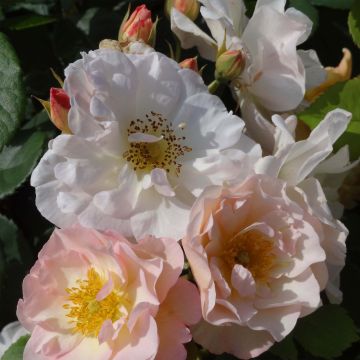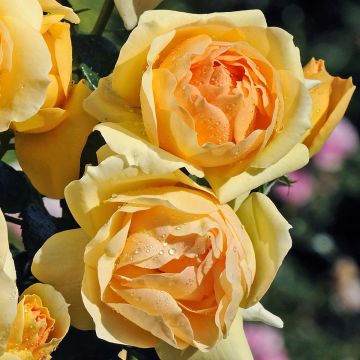

Rosa floribunda Bordeaux


Rosa floribunda Bordeaux


Rosa floribunda Bordeaux


Rosa floribunda Bordeaux
Rosa floribunda Bordeaux
Rosa x floribunda Bordeaux® 'Korelamba'
Floribunda Rose
Included in my "good young plants" basket. Looks healthy, looking forward to seeing it bloom.
Chantal, 14/10/2024
Special offer!
Receive a €20 voucher for any order over €90 (excluding delivery costs, credit notes, and plastic-free options)!
1- Add your favorite plants to your cart.
2- Once you have reached €90, confirm your order (you can even choose the delivery date!).
3- As soon as your order is shipped, you will receive an email containing your voucher code, valid for 3 months (90 days).
Your voucher is unique and can only be used once, for any order with a minimum value of €20, excluding delivery costs.
Can be combined with other current offers, non-divisible and non-refundable.
Home or relay delivery (depending on size and destination)
Schedule delivery date,
and select date in basket
We guarantee the quality of our plants for a full growing cycle, and will replace at our expense any plant that fails to recover under normal climatic and planting conditions.
Description
The Bush Rose Bordeaux® 'Korelamba' is a Kordes creation, a bush rose with large velvety flowers whose name reflects the Bordeaux colour. It has a regular, upright silhouette, well-suited for flower beds and borders. Its double flowers, with a wide and full cup shape, emit a pleasant fruity fragrance. This rose blooms continuously until the frost, with healthy foliage resistant to powdery mildew and blackspot.
The 'Bordeaux' Rose is a modern bush rose with large flowers bred by Kordes in 2014. It is a hybrid of the Rosa floribunda, very cold and disease resistant. It forms a bushy and upright shrub with vigorous and strong vegetation, reaching a height of approximately 80 cm (32in) and a width of 50 cm (20in) at maturity. It produces strong and thorny branches that bear very dark green foliage, which is resistant to diseases. From May to October, if the faded flowers are removed, the plant continuously produces large flowers with a diameter of 10 cm (4in), in well-filled cups. They are of an intense Bordeaux red colour. Solitary, they are carried at the end of long shoots from the current year or emerging from the 2-year-old stems.
This 'Bordeaux' rose is ideal for small spaces due to its modest dimensions. Its upright and regular habit makes it a good plant for flower beds and borders. Pair it with light blue-flowered perennials, such as sages, geraniums, or mauve-colored nepetas. Sow nigella seeds. Plant silver-leaved plants like Artemisia or purple-leaved plants like Heucheras. Golden spike grasses make a beautiful complement to its red flower. With their beautiful dark reflections, small bushes like Berberis or Physocarpus also enhance its beauty.
Report an error about the product description
Rosa floribunda Bordeaux in pictures






Plant habit
Flowering
Foliage
Botanical data
Rosa
x floribunda
Bordeaux® 'Korelamba'
Rosaceae
Floribunda Rose
Cultivar or hybrid
Planting and care
Plant your 'Bordeaux' Rose in a sunny or lightly shaded position. Modern roses are tolerant, but they do not appreciate excessive limestone. They will adapt to any garden if the soil is well-worked, not too heavy, and sufficiently rich. To install your rose, work the soil by crumbling it and place an amendment, such blood,fish and bone, at the bottom of the planting hole. Water generously after planting to eliminate air pockets. Water regularly for a few weeks to facilitate root establishment.
Pruning modern perpetual roses is essential for flowering. It is done in three steps:
1. Maintenance pruning: regularly shorten the flowering shoots during the season. Remove faded flowers along with their stem to encourage the reblooming of perpetual roses, leaving 2 or 3 leaves.
2. Preparatory pruning in autumn: light pruning precedes spring pruning. In regions with cold winters, it is not recommended to avoid weakening the bush.
3. Spring pruning: in February-March, when the buds have grown into shoots 2 to 3 cm (1in) long, prune the young, strong branches by a quarter of their length.
Pruning always aims to open the bush's centre and remove dead wood, diseased branches, and weak shoots. The most vigorous branches, usually 3 to 6 well-positioned, should be retained to maintain an attractive habit. Always prune at a diagonal, ½ cm to 1 cm (0in) above an outward-facing bud.
Roses are often stained or unsightly at the end of summer, but this is not a problem for their development. These stains are not harmful to the rose but are natural.
Planting period
Intended location
Care
-
, onOrder confirmed
Reply from on Promesse de fleurs
Similar products
Haven't found what you were looking for?
Hardiness is the lowest winter temperature a plant can endure without suffering serious damage or even dying. However, hardiness is affected by location (a sheltered area, such as a patio), protection (winter cover) and soil type (hardiness is improved by well-drained soil).

Photo Sharing Terms & Conditions
In order to encourage gardeners to interact and share their experiences, Promesse de fleurs offers various media enabling content to be uploaded onto its Site - in particular via the ‘Photo sharing’ module.
The User agrees to refrain from:
- Posting any content that is illegal, prejudicial, insulting, racist, inciteful to hatred, revisionist, contrary to public decency, that infringes on privacy or on the privacy rights of third parties, in particular the publicity rights of persons and goods, intellectual property rights, or the right to privacy.
- Submitting content on behalf of a third party;
- Impersonate the identity of a third party and/or publish any personal information about a third party;
In general, the User undertakes to refrain from any unethical behaviour.
All Content (in particular text, comments, files, images, photos, videos, creative works, etc.), which may be subject to property or intellectual property rights, image or other private rights, shall remain the property of the User, subject to the limited rights granted by the terms of the licence granted by Promesse de fleurs as stated below. Users are at liberty to publish or not to publish such Content on the Site, notably via the ‘Photo Sharing’ facility, and accept that this Content shall be made public and freely accessible, notably on the Internet.
Users further acknowledge, undertake to have ,and guarantee that they hold all necessary rights and permissions to publish such material on the Site, in particular with regard to the legislation in force pertaining to any privacy, property, intellectual property, image, or contractual rights, or rights of any other nature. By publishing such Content on the Site, Users acknowledge accepting full liability as publishers of the Content within the meaning of the law, and grant Promesse de fleurs, free of charge, an inclusive, worldwide licence for the said Content for the entire duration of its publication, including all reproduction, representation, up/downloading, displaying, performing, transmission, and storage rights.
Users also grant permission for their name to be linked to the Content and accept that this link may not always be made available.
By engaging in posting material, Users consent to their Content becoming automatically accessible on the Internet, in particular on other sites and/or blogs and/or web pages of the Promesse de fleurs site, including in particular social pages and the Promesse de fleurs catalogue.
Users may secure the removal of entrusted content free of charge by issuing a simple request via our contact form.
The flowering period indicated on our website applies to countries and regions located in USDA zone 8 (France, the United Kingdom, Ireland, the Netherlands, etc.)
It will vary according to where you live:
- In zones 9 to 10 (Italy, Spain, Greece, etc.), flowering will occur about 2 to 4 weeks earlier.
- In zones 6 to 7 (Germany, Poland, Slovenia, and lower mountainous regions), flowering will be delayed by 2 to 3 weeks.
- In zone 5 (Central Europe, Scandinavia), blooming will be delayed by 3 to 5 weeks.
In temperate climates, pruning of spring-flowering shrubs (forsythia, spireas, etc.) should be done just after flowering.
Pruning of summer-flowering shrubs (Indian Lilac, Perovskia, etc.) can be done in winter or spring.
In cold regions as well as with frost-sensitive plants, avoid pruning too early when severe frosts may still occur.
The planting period indicated on our website applies to countries and regions located in USDA zone 8 (France, United Kingdom, Ireland, Netherlands).
It will vary according to where you live:
- In Mediterranean zones (Marseille, Madrid, Milan, etc.), autumn and winter are the best planting periods.
- In continental zones (Strasbourg, Munich, Vienna, etc.), delay planting by 2 to 3 weeks in spring and bring it forward by 2 to 4 weeks in autumn.
- In mountainous regions (the Alps, Pyrenees, Carpathians, etc.), it is best to plant in late spring (May-June) or late summer (August-September).
The harvesting period indicated on our website applies to countries and regions in USDA zone 8 (France, England, Ireland, the Netherlands).
In colder areas (Scandinavia, Poland, Austria...) fruit and vegetable harvests are likely to be delayed by 3-4 weeks.
In warmer areas (Italy, Spain, Greece, etc.), harvesting will probably take place earlier, depending on weather conditions.
The sowing periods indicated on our website apply to countries and regions within USDA Zone 8 (France, UK, Ireland, Netherlands).
In colder areas (Scandinavia, Poland, Austria...), delay any outdoor sowing by 3-4 weeks, or sow under glass.
In warmer climes (Italy, Spain, Greece, etc.), bring outdoor sowing forward by a few weeks.








































